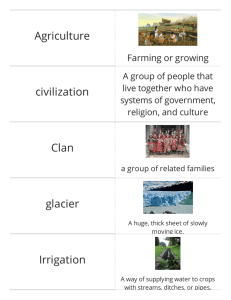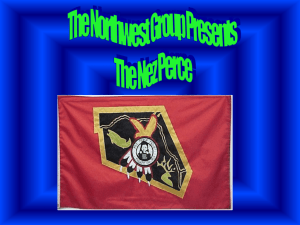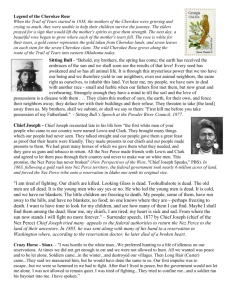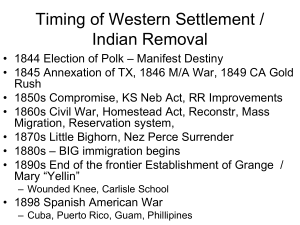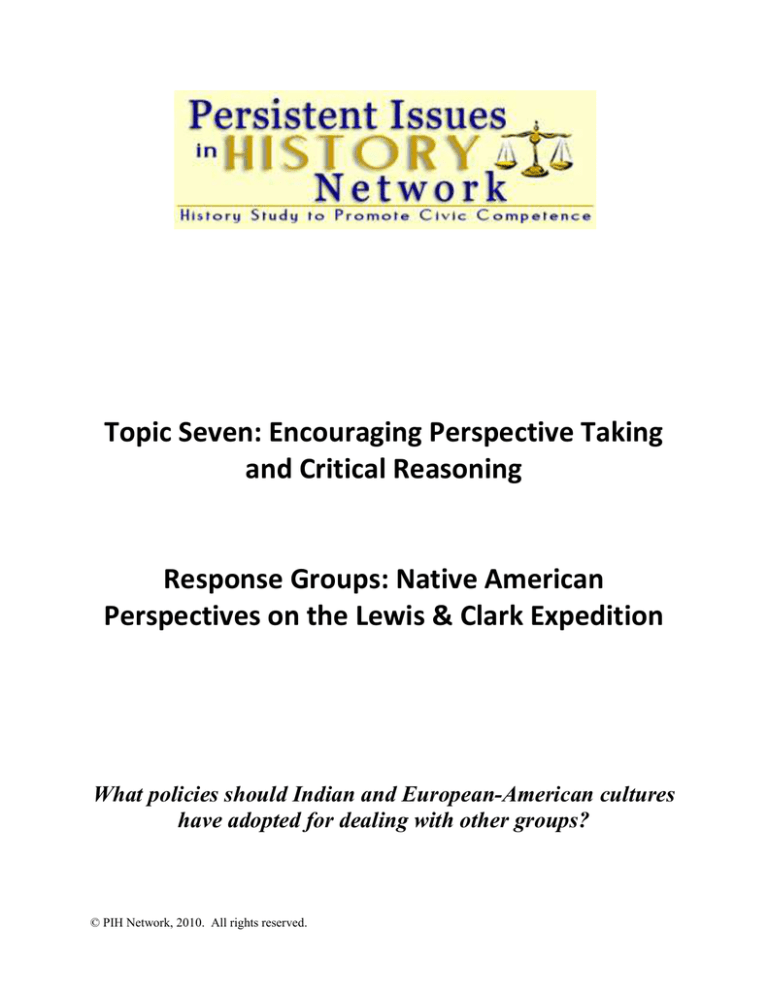
Topic Seven: Encouraging Perspective Taking
and Critical Reasoning
Response Groups: Native American
Perspectives on the Lewis & Clark Expedition
What policies should Indian and European-American cultures
have adopted for dealing with other groups?
© PIH Network, 2010. All rights reserved.
Response Group Activity: Native American Perspectives on the Lewis & Clark Expedition
Lesson Procedures
CQ: What policies should Indian and European-American cultures have adopted for dealing with
other groups?
Purposes:
1. Provide historical context and background knowledge for the reciprocity between Native
American groups’ lifestyles and their geographic locations.
2. Encourage historical perspective-taking.
3. Encourage use of historical and geographic evidence to construct a proposed response to
the Lewis and Clark expedition by a unique Native American group.
4. Encourage comparison and contrast between the proposed responses of unique Native
American groups.
Lesson Narrative:
Introduction:
1. The teacher will begin the lesson by discussing the commissioning of the Lewis & Clark
expedition with the students. Students should be introduced to the expedition with
regards to goals (to gain an accurate sense of the resources gained in the large land
purchase just made by the United States government, map the new territories, and look
for connecting waterways), recent events (including discussion of the LA Purchase), and
(briefly) the men involved in leading the expedition. The teacher may wish to introduce
students to the expedition by utilizing video clips (ex: opening moments/title sequences
from Ken Burns’ Lewis and Clark: Journey of the Corps of Discovery or National
Geographic’s Lewis and Clark: Great Journey West) or a brief reading from Thomas
Jefferson.
2. In addition to briefly presenting the origins, goals, and men behind the expedition, the
teacher will utilize a projected Google Earth document (LC.kml) to give the students an
overview the path the expedition will take as it moves west. This map includes five
markers that note the locations of five encounters the expedition will have with Native
American groups:
a.
b.
c.
d.
e.
Missouri/Oto
Teton Sioux (Lakota)
Mandan/Hidatsa
Shoshone
Nez Perce
3. The teacher will note that the Corps of Discovery will have a unique experience with
each tribal group but should be careful not to “give away” any details of each encounter.
© PIH Network, 2010. All rights reserved.
Constructing a response to one these encounters with Lewis and Clark will be the task of
the students in today’s lesson.
Body:
1. Divide students into five groups with each group representing one of the above Native
American groups. Each student group will be given a packet containing background
information and two brief readings. Additionally, students will be provided with
scaffolding questions to aid in their analysis of their group.
2. Because the physical and cultural geography associated with these groups is significant,
students should also be given access to computers w/internet access and the
aforementioned Google Earth file (LC.kml). Students will also be given instructions for
using Google Earth and scaffolding questions to guide them in exploring the territory of
their assigned group, landforms, and reciprocity between the people and the land. Each
place-mark on the map can be expanded to provide five tribe-specific images with
questions for students to ponder as they construct their response.
3. Students are tasked with constructing their group’s response to the Corps of Discovery. In
doing so, they will be asked to consider multiple factors and answer many questions.
Using the evidence provided in the readings, images, and Google Earth file, students will
construct/predict a historically reasonable response to the expedition (See attached
student instructions/assignment sheet).
4. After students have had time to work with the packets, Google Earth, and associated
scaffolds, the teacher will reconvene the whole class. Each student group will present
their Native American group to the rest of class with a focus on history and
characteristics of the tribe before presenting their proposed plan for how they will
respond to the arrival of the expedition in their lands.
5. After each presentation, the teacher will review the proposed response and
compare/contrast with other groups’ proposals. When necessary, help the students in
connecting their descriptions of their groups with the proposed plan of action. Further,
after each student group presentation, the teacher will reveal the details of the actual
encounter through use of a slide-show presentation containing journal entries and details
of the actual encounters.
6. As the teacher presents the encounters, students will record the details of each in a data
retrieval document that includes all five tribal groups. After each encounter is discussed,
the teacher should take time to compare and contrast with the previous encounter so that
students understand the unique character of each, and the factors that influenced the
experience. (The teacher may wish to utilize video clips from the documentary pieces
mentioned above, as many of the encounters are dramatized therein.)
© PIH Network, 2010. All rights reserved.
Conclusion:
1. The teacher will review the five major encounters of the Lewis and Clark expedition and
discuss the immediate and long-term outcomes of the expedition on the Native
Americans groups that encountered the expedition.
2. The lesson may be extended by having students read an essay by a contemporary Native
American author that recounts the longer-term impacts of the Corps of Discovery on
native peoples.
© PIH Network, 2010. All rights reserved.
The Corps of Discovery is coming: How will you Respond?
You and a group of classmates will be assigned to represent a specific Native American group in
the year 1804. At some point in the coming months, each of your groups will encounter the
members of the Corps of Discovery led by Meriwether Lewis and William Clark. This
expedition’s stated purpose is to gain an accurate sense of the resources gained in the large land
purchase just made by the United States government, map the new territories, and look for
connecting waterways. In reality, you understand that the approaching expedition is also set with
the purpose of informing you that your land now belongs to the government of the United States.
The expedition likely intends to meet with you, learn about you, and offer some gifts on behalf
of the government to the east. You will decide how your Native American group will respond to
the expedition.
There is no single correct answer for this task. After your group has determined its approach in
dealing with the expedition and presented this to the other tribal groups, we will discuss the
details of the actual encounter between your group and Lewis and Clark. Do not feel that you
must reach this exact same conclusion in your finished product. However, your response should
be historically reasonable, logical, and based on evidence. In reaching your decision(s) you will
be asked to consider many factors including the following:
Geographic location of your tribe(s)
Culture of your tribe(s)
Livelihood of your tribe(s)
Alliances/enemies of your tribe(s)
Recent history of your tribe(s)
Current needs of your tribe(s)
Ultimately, you will introduce your tribe and present your plan for response that will guide your
actions when you encounter the members of the Lewis and Clark expedition. Your response
should reflect the above knowledge of your people and make sense given this information.
Because multiple considerations will go in to your decisions, you will be asked to explain to the
other tribal groups why you decided on this response for your group and why the decision makes
sense. Convince us it is the best option for your tribe(s).
Resources:
In addition to a brief introduction to the expedition provided by your teacher, you will have
access to a number of resources to guide you as you decide your response to the Corps of
Discovery. Each group will be given access to general background information, readings, and
images pertaining to your tribal group. You will also be provided with a Google Earth file to aid
in understanding the location and terrain of your people.
© PIH Network, 2010. All rights reserved.
The Corps of Discovery is coming: How will you respond?
A. Background Information for ______________________________________
(Tribe/Group Name)
Complete the following as you analyze the readings, answer the reading comprehension
questions, and examine the images pertaining to your Native American group.
1. In what region of the country does your group live?
2. What activities are central to the life of your group? How do you survive?
3. What groups are allies or friends to your group? How do your people benefit from this
relationship?
4. Does your tribal group have any enemies or ongoing conflicts?
5. Describe your dwelling (home). Why is this dwelling the best option for your people?
6. List three adjectives that you believe best describe your people and provide evidence.
© PIH Network, 2010. All rights reserved.
B. Preparing a Response to the Corps of Discovery
In addition to introducing your tribal group, you will also deliver your plan for response to Lewis
and Clark. Consider your answers to the reading and image-based questions as you craft your
response and defend. Before crafting your written response, consider the following:
1. Character of the Encounter: Do you believe that your encounter will be characterized
by violence or will it likely be peaceful and cordial?
2. Needs: What do your people currently need? What do you hope to get from the members
of the expedition?
3. Offerings: What can your group offer members of the expedition? How will this help
Lewis and Clark? Will you choose to offer assistance?
4. The Future: What long-term goals do you have that could be assisted by another
encounter with agents of the U.S. government? Will this encounter be the beginning of a
longer relationship with the United States?
© PIH Network, 2010. All rights reserved.
Missouri/Oto
Background Information and Timeline of Significant Events:
You represent the Missouri and Oto, two closely related tribes in present day Iowa,
Missouri, and parts of Nebraska. You will be the first tribal group encountered by
Lewis and Clark. Due to your location, your group is more familiar with whites
that many of the tribes to the west. However, your location has led to many
epidemics of smallpox and other diseases. Disease has killed so many of your
people that both groups are currently living together in one village made up of
about 250 people. Both tribes are primarily sedentary farmers but become more
nomadic and hunt buffalo in the summer months. For most of the year, your people
live in earth-covered, oven-shaped houses grouped into towns.
Disease is not the only problem faced by the Missouri tribe, as this tribe is also in
constant conflict with other Native American groups, most notably the Sauk and
Fox. Attacks by these nearby tribes have been factored into the group’s decision to
join with the Oto. Both groups have retained their leadership since joining
together, and Oto Chief “Little Thief” and Missouri Chief “Big Horse” are both
leaders.
Because you will be the first Native Americans encountered by Lewis and Clark,
your response to the expedition must be carefully considered.
Significant Dates
1655: The Oto first encounter French traders.
1673: The Missouri Indians were visited by French explorer Jacques Marquette,
leading to eventual trade with the French.
1798: The Missouri suffered severe defeat by Sauk & Fox, moved to live with Oto
1804: The Missouri and Oto are living together near the mouth of the Platte River.
Sources:
http://www.fourdir.com/missouria.htm, http://www.fourdir.com/oto.htm
http://www.pbs.org/lewisandclark/native/idx_mis.html
© PIH Network, 2010. All rights reserved.
Missouri/Oto Reading #1
A description of Oto life just before the expedition of Lewis and Clark
Before the disintegration of the old culture, the Oto did not live together as a tribe, but they
formed villages which were essentially voluntary groupings of families. In these villages of mud
lodges which were set up along the rivers, the people lived the greater part of the year. The men
hunted along the neighboring streams; the women hoed and planted and cared for their gardens
in the river bottoms. When game grew scarce or the villages became dirty or the pressure of
neighboring tribes compelled them to move, the Oto would gather together their possessions and
packing them on their backs, move to a new site where the hearth fires would be relit and the old
life begun all over again.
In distinction to the sedentary village life was the bi-annual buffalo hunt when, during the
spring and fall, the Oto wandered over the plains in search of buffalo, each family with its own
skin tipi. This family consisted of a man and his wife and unmarried children. To this group
might be added a married daughter and son-in-law or some unattached close blood relative.
Village life outranked the life of the buffalo hunt in importance. A village might be made up
of forty to seventy mud lodges…These houses were occupied by families and close relatives.
The labor of providing a livelihood was shared by a man and his wife and such children as were
old enough to help. Men were essentially engaged in hunting; women in the care of lodge and
children. Men and women worked in the village gardens together, though women took over a far
larger share of this work than the men.
...Ideally, an Oto man was courageous, gentle, truthful, and above all generous. Ideally, an Oto
woman was faithful, hardworking, and the mother of lively and respected children.
...An Oto boy was given horses and blankets by his father to give-away at ceremonies before he
was old enough to appreciate what he was doing. A man began to give early in life. The fruits of
his first hunting he gave to his father and to his near relatives who in return blessed him. His
relatives helped him to “buy” his bride; but it was his father-in-law for whom he hunted and to
whom he gave his game; and after the birth of his first child it was his own family, his own
children whom he honored by gifts and give-aways and honoring ceremonies.
...In the old days, I was told, the Oto did not have the give-away. They were a poor people and
had so little above the subsistence level that the give-away was not feasible. But as they
advanced more and more into the Plains, acquired the horse, and so were better fitted to hunt the
buffalo, they quickly acquired the give-away and its associated complexes. With the acquisition
of riches they honored with riches. But the emphasis, especially economic, was not quite the
same as we find among the Dakota Sioux, who honor by giving away to the poor who can make
no immediate return. With the Oto the institution more frankly served economic ends. Gifts
among the Oto were more frequently given and honor more openly paid to those individuals who
could and would make a return gift with interest
Source:
Whitman, W. (1936). The Oto. New York: AMS Press.
© PIH Network, 2010. All rights reserved.
Missouri/Oto Reading #2
Missouri and Oto society members were divided into seven to ten clans. The clan chiefs formed
a tribal council, with the Bear and Buffalo clans providing the principal leadership.
Richard Shunatona, Keeper of Peace Pipe and Chief of the Buffalo Clan, Furnishes Important
Information Upon the Chiefs, Customs and Traditions of the Otoe Tribe:
In olden times there were only seven chiefs of the tribes. Each chief was a keeper of a Peace pipe
which was their symbol or insignia. To become a chief of the tribes was no easy matter, for it
required something more than [being] a member of the [old chief’s] family to be one. In order to
be initiated into the secret order of the Chief's lodge one must be a student of the great
schoolroom of Nature, for really a chief must be able to teach the tribes.
The Otoe and Missouria Tribes are divided into bands or clans, with chiefs, symbols, badges,
etc. The influence of names and families is strictly kept up and their qualities and relative
distinction preserved in heraldic family arms. The Otoe and Missouria Tribes have two ruling
families, Ah-lu-qwa, or Buffalo Clan and the Tu-nah-be, or Bear Clan.
When the moon begins to warm mother earth and when the grass and the leaves begin to have
a coat of green, or during the last quarter of Ma-gan-na, (plow month) or the month of April, the
Ah-lu-qwa is the ruler of the tribes and is to be respected.
When the moon begins to cool mother earth and when the leaves turn brown and begin to
drop back to earth, or during the last quarter of Tah-ke-lu- rscha, (mating of deers) or the month
of October, the Tu-nah-be becomes the ruler of the tribes. When the change is made certain rites
and rituals are performed.
Source:
http://www.usgennet.org/usa/ne/topic/resources/OLLibrary/Journals/HPR/Vol05/nhrv05p8.html
Reading #1:
1. Why might the lifestyle of the Missouri and Oto best be described as semi-nomadic?
2. Describe the typical Missouri/Oto dwellings and villages.
3. What was the role of gift-giving in Missouri/Oto society?
Reading #2
4. How did the various clans of the Oto and Missouri tribes share leadership? How might
this system affect dealings with outsiders?
© PIH Network, 2010. All rights reserved.
Teton Sioux
Background Information and Timeline of Significant Events:
You are members of the Teton Sioux, also known as the Lakota. You have long
been in control of the Great Plains, with most of your people remaining nomadic
while some occupy two villages near present-day Pierre, South Dakota. Virtually
all members of your group have found tipis to be the best dwelling for your
lifestyle. Warlike and powerful, the members of your tribe live in a constant state
of war with other groups, and you are intent on controlling all traffic through your
region of the Missouri River. Because your military might is apparent to anyone
travelling through, you often demand and receive gifts from travelers. Thus, your
allies are few and far between.
The Teton Sioux are known to trade with the Mandan and Hidatsa, even though
you are often at odds with these groups. A somewhat more stable relationship
exists with the nearby Arikara as you regularly trade clothes and guns in exchange
for the Arikara’s corn and horses. Even so, the Arikara are aware of the military
might of your people and fear you. Perhaps more interesting is your relationship
with the Cheyenne. The Lakota and Cheyenne have been enemies and fought wars
over territory, but have at times formed alliances. Both your people and the
Cheyenne are growing increasingly wary of the expansion of whites further west
into your territories.
Significant Dates:
1640: First contact with whites recorded by Jesuit missionaries
1765: Some first reached the Black Hills of the Dakotas, driven there by
Chippewa
1801: Smallpox epidemic kills many Lakota
Sources:
http://www.fourdir.com/lakota.htm,
http://www.pbs.org/lewisandclark/native/tet.html
© PIH Network, 2010. All rights reserved.
Teton Sioux Reading #1
A description of the ear-piercing customs long practiced by the Lakota, this account gives clues
about how the Lakota viewed themselves in relation to others and provides a glimpse of rituals.
Piercing the ears is a custom that the Oglala (another Sioux group) and Lakota have practiced
from ancient times. This is done to show that they are Lakota. Anyone may have his ears pierced,
a man, a woman, or a child. This is a sign that the one having his ears pierced will live according
to the Lakota customs and obey their laws. It obligated such a one to side with the Lakota against
all others of mankind. Usually the parents had their children’s ears pierced when the children
were small. It was so in former times.
Then when the Sun Dance was danced, all the children whose ears were not pierced and who
had been born since the last Sun Dance, had their ears pierced while the dancers were dancing.
But it was not necessary to have the ears pierced at a Sun Dance. Anyone might have the ears
pierced at any time. Usually someone was chosen to do this. A shaman or holy man was usually
chosen to perform the operation. The ears were pierced with anything sharp enough to do so.
Formerly this was done with a pointed stone or an awl (a tool used for piercing wood or leather).
The shaman performed a ceremony and sang his song to his ceremonial bag. Then he pierced the
ears and urged the one whose ears were pierced, or the parents of such a one, to live as Lakota
and to observe all the customs of the Lakotas.
If the one had a name he might keep it, or the one who pierced the ears might give a new
name when the operation was done. If a new name was given, the one who gave it became
godfather to the one who received it.
...One whose ears are to be pierced is laid on a bed of sage. The one who is to pierce the ears
should kneel at the head of the person whose ears he is to pierce and place a block of wood under
the ear and with a knife or sharp tool pierce the ear, one or more times as has been agreed upon.
The he should pierce the other ear in a like manner. The hole made by the piercing may be large
or small as agreed upon and it may be at any part of the ear desired…One who pierces an ear is
obligated to see to it that the one whose ear is pierced is taught the customs of the Lakotas.
...A holy man or the council may proclaim that anyone is entitled to have the ears pierced. One
whose ears are pierced is entitled to the respect of his people, unless he disgraces himself.
Sources:
Interview with Rocky Bear, a Lakota, collected by James Walker, February 1, 1905. (excerpted
and paraphrased)
Walker, J.R. Lakota Belief and Ritual. Lincoln: University of Nebraska Press.
© PIH Network, 2010. All rights reserved.
Teton Sioux Reading #2
A discussion of the meaning of various Lakota war insignia and symbols…
One who kills a renowned enemy is entitled to wear a feather suspended from the pierced ear.
...If during a battle the enemy charges on the Lakota and the Lakota meet the charge and drive it
back, a Lakota who strikes one of the enemy with a club or stick is entitled to wear an eagle quill
fastened upright to his scalp lock. If he was wounded, he is entitled to color the quill red, but if
he was not wounded then the quill must not be colored. A Lakota who has been wounded by
gunshot is entitled to wear a lead bullet suspended about his neck.
...If a Lakota kills an enemy, he is entitled to wear a quill from the tail of the eagle, such as are
white, tipped with black. He should wear it fastened to his scalp lock so that it will stand upright.
If he was wounded he may color the quill red.
...If he (the Lakota), was wounded in the body he should put stripes of blue across a yellow
quill, or if he was wounded in the limbs he should put stripes of red across it. (The blue is
emblematic of the protection the Wakan Tanka (Great Spirit) gave him and prevented his spirit
from leaving him. The red is symbolic of the Wakan Tanka, who preserved his life and gave him
strength to escape even with his limbs wounded).
...A Lakota who is blotanhunka, in command of a war party, and who returns from a foray
bringing scalps, women, or horses, is entitled to wear a quill from the tail of the eagle colored
blue. A Lakota who has taken a scalp is entitled to carry the red staff. This is made from a
chokecherry bush, about two short paces long, and is forked at the smaller end. It should be as
large as a man’s great toe at its larger end, and painted red. He may attach the scalp to the forked
end and may also attach other insignia to it as he is entitled to have.
Source:
Interview with Thunder Bear, a Lakota, collected by James Walker, 1912. (excerpted and
paraphrased)
Walker, J.R. Lakota Belief and Ritual. Lincoln: University of Nebraska Press.
Reading #1
1. Describe the Lakota ear-piercing custom. Why did the Lakota advocate ear-piercing?
2. Based on the reading, why might the Lakota value being set apart from all others?
Reading #2
3. What actions could earn a Lakota the right to wear feathers and other symbols?
4. Why might the Lakota have valued displays of symbols such as these? How do you think
other tribes viewed and interacted with the Lakota?
© PIH Network, 2010. All rights reserved.
Mandan/Hidatsa
Background Information and Timeline of Significant Events:
Your group, the Mandan and Hidatsa , is actually a community made up of allied
groups that live closely together in present day North Dakota. The early Mandan
and Hidatsa frequently intermarried and this practice continues today. Children are
taught to speak the language of their mother but can understand members of both
groups. The Mandan live in two villages on opposite river banks of the Missouri
River. The Hidatsa live in three nearby villages. Their villages are made up of
numerous round earthen lodges that cluster around a central plaza. A tall cedar post
representing a heroic tribal warrior stands at the center of the Mandan villages.
Rituals and ceremonies are important to the lives of both groups, and the Hidatsa
even send war parties west to engage the Shoshone and Blackfeet Indians for
ritualistic reasons as well as reasons of wealth, protection, and revenge.
Both groups are ideally located at the center of trade for the Upper Missouri
region, and trade with a variety of Europeans as well as Native American groups.
Your people grow crops like corn, beans, and squash for trade, and every autumn
brings numerous visitors to the villages of the Mandan and Hidatsa to trade a wide
variety of items including horses, meats, and musical instruments for the crops.
Especially prized is Mandan corn, and even the warlike Teton Sioux come to the
villages to trade for crops such as this. Like many Native Americans in this region,
the hunting of buffalo is also central to tribal life.
Due to your favorable trading status and experience with many groups, you also
possess a vast array of geographic knowledge about the surrounding lands.
Significant Dates:
1450: Approximate dated of Mandan arrival in North Dakota
1804: By this date, the Mandan and Hidatsa are living closely together in the Knife
River region, and are the facilitators of most of the region’s trade.
Sources:
http://www.pbs.org/lewisandclark/native/idx_oto.html
http://www.fourdir.com/mandan.htm, http://www.fourdir.com/hidatsa.htm
© PIH Network, 2010. All rights reserved.
Mandan/Hidatsa Reading #1
In Mandan and Hidatsa agriculture, the women owned and worked the gardens of corn, beans,
and squash. Women and girls planted, weeded, and harvested the crops together. The following
account by a Hidatsa woman known as Maxidiwiac or “Buffalo Bird Woman” tells of many
agricultural customs of the region.
Soon after they came to Like-a-fishhook bend, the families of my tribe began to clear fields, for
gardens, like those they had at Five Villages. Rich black soil was to be found in the timbered
bottom lands of the Missouri. Most of the work of clearing was done by the women.
In old times we Hidatsas never made our gardens on the untimbered prairie land, because the
soil there is too hard and dry. In the bottom lands by the Missouri, the soil is soft and easy to
work.
My mothers and my two grandmothers worked at clearing our family’s garden. It lay east of
the village at a place where many other families were clearing fields. I was too small to note very
much at first. But I remember that my father set boundary marks---whether wooden stakes or
little mounds of earth or stones, I do not now remember---at the corners of the field we claimed.
My mothers and my two grandmothers began at one end of this field and worked forward. All
had heavy iron hoes, except Turtle (the storyteller’s grandmother), who used an old-fashioned
digging stick.
...I have heard that in very old times, when clearing a new filed, my people first dug the corn
hills with digging sticks; and afterwards, like my mothers, worked between the hills, with bone
hoes. My father told me this.
...Whether stone axes were used in old times to cut the trees and undergrowths, I do not know. I
think fields were never then laid out on ground that had large trees on it.
...It was our Indian rule to keep our fields very sacred. We did not like to quarrel about our
garden lands. One’s title to a field once set up, no one ever thought of disputing it; for if one
were selfish and quarrelsome, and tried to seize land belonging to another, we thought some evil
would come upon him, as that some one of his family would die. There is a story of a black bear
who got into a pit that was not his own, and had his mind taken away from him for doing so!
Sources:
Hoxie, F.E., and Nelson, J.T. (Eds.). Lewis and Clark and the Indian Country: The Native
American Perspective. Chicago: University of Illinois Press.
Wilson, G.L. Buffalo Bird Woman’s Garden. St, Paul: Minnesota Historical Society Press.
© PIH Network, 2010. All rights reserved.
Mandan/Hidatsa Reading #2
The following reading is an excerpt from an interview with Malcolm Wolf, a modern-day leader
in a reservation community made up of Mandans and Hidatsas. Here he discusses the historical
importance of clan and family life to his people.
All of a sudden we had other people who came up the river and perished with a sickness; you
won’t believe what happened. We are told their sickness was so bad in their back it would go
into their spine, their cartilages, and they would just die there (this is likely a reference to a
smallpox outbreak, as the disease causes severe back pain). They were all standing and would
go walking every which way, running from each other…How pitiful my people must have been
at that time. That’s why our clans were lost, because many people died. Then there was just
seven left, so we joined together. Our clanship brought us together. You asked how do people get
together after that and live together? Because of our clanship system; it is powerful because it
was given to us by a higher power. That is why we bonded together, that’s how we survived, and
that’s why we are still here today. There are very few people that have that; and we are very
strong and we live by that today. That governs and gauges, socially, economically, you name it;
we have two groups of clans and that governs what we do.
...You can be an orphan with no mother, no father, no brothers and sisters, but if you have a
clan you still have family. That is the whole concept. We don’t have a word for aunt or uncle or
cousin. We use “brother,” “mother,” or “grandpa”; that is how we are related. Cousins and
nephews and nieces are our sons or our brothers or our sisters. An aunt we call [native word],
that’s my dad’s clan’s sisters. Those are the people that I would wait on. I would have a kill and I
would take that meat to them first I would let them take what they wanted and then I would go
on back to my place, my lunch. That’s how we took care of each other; we never owed each
other, we didn’t borrow. We gave to one another and never talked about it; that’s how we bonded
together, that’s how we stayed together. It’s a beautiful system. And you wonder how we did it,
how did we survive? That’s how we did it.
Source:
Hoxie, F.E., and Nelson, J.T. (Eds.). Lewis and Clark and the Indian Country: The Native
American Perspective. Chicago: University of Illinois Press.
Reading #1:
1. Why was agriculture so important to Mandan and Hidatsa livelihood and survival?
2. What roles did women play in Mandan and Hidatsa culture?
Reading #2:
3. According to the author of the second reading, what caused many Mandan and Hidatsa
Indians to perish? How did they respond?
4. What examples do both authors use to illustrate the sense of community felt by the
Mandan and Hidatsa people?
© PIH Network, 2010. All rights reserved.
Shoshone
Background Information and Timeline of Significant Events:
You represent the Shoshone. Also known as the Snake Nation, your people live on
both sides of the Rocky Mountains. The differences in climate and availability of
resources to each group have led the Shoshone to develop distinctly different
cultures. Those to the west of the mountains live in grass huts and hunt small
game, while the groups to the east live in teepees and hunt buffalo. Salmon is an
important source of food to both groups. It is your people, the Lemhi Shoshone of
the northeast, who are most likely to encounter Lewis and Clark.
The Lemhi Shoshone are talented horsemen and fighters, but have recently been
driven off the plains of Montana by Blackfeet, Atsina, and Hidatsa groups.
Currently your people are living in teepees and eating roots, berries, and small
game. The central reason for this series of defeats and migrations is use of guns by
the other tribes. The Spanish, your traditional trading partners, have refused to give
the Shoshone guns. Driven westward and living in poverty, many Shoshone
women have cut their hair short in mourning for the tribe’s fortunes. Other females
of the tribe had been captured by the aforementioned groups.
Still, you have kept hope alive through ritual and dancing, and are making plans to
retake your old buffalo-hunting grounds. Because of limited contact with whites,
you are especially unsure of what the coming expedition of Lewis and Clark will
bring.
Significant Dates:
1700: The Lemhi Shoshone and their Bannock neighbors joined groups like the
Nez Perce in being among the first to acquire horses.
Late 1700s: The Lemhi Shoshone are driven off their traditional hunting lands.
Sources:
http://www.pbs.org/lewisandclark/native/sho.html
http://www.fourdir.com/bannock.html
© PIH Network, 2010. All rights reserved.
Shoshone Reading #1
The following is a description of the importance of salmon, river life, and dance to the Shoshone
in their ideal environment. By time of Lewis and Clark’s arrival, however, this way of life was in
disarray.
...With a moderate elevation of about 3,000 feet, Sehewoki’i (the Shoshone name for their
territory) provided excellent winter camp locations, but fall and spring salmon runs furnished the
most important rationale for wintering there and contributed to a more sedentary existence than
was possible in the basin.
The importance of salmon to human existence in the Snake country illuminated fundamental
characteristics of the Shoshone’s spirituality and social organization, as well as their
complementary gendered divisions of labor and concepts of property. To ensure a successful
season of fishing and gathering, families observed the nu’akin dance for several days in
anticipation of the first salmon of the season. Men and women stood between members of the
opposite sex in a dance circle, while boys and girls separately formed circles in front of and
behind the main circle. The three circles of dancers sang songs and joined hands in a custom
called ma’wekwagin to symbolize cyclical renewal and community. Shoshones also celebrated
the ta’ma-a’gai (first salmon) with an essential ceremony of plateau origins. Participants held a
feast to observe proper relations with the salmon spirit and divided the first catch among band
members to reinforce the ethic of sharing.
...The end of the spring salmon runs signaled the beginning of the seasons of travel. Shoshones
made their way, using carefully selected routes to maximize a variety of resources, to the camas
prairies near present-day Fairfield, Idaho, where they dug camas roots (1). On arriving at the
prairies, they found an assemblage of Shoshones and plateau peoples from across the Snake
country and beyond. An ensuing trade fair generated a festive atmosphere for exchanges, visits,
stories, games, rituals, and celebrations—the intimate, face-to-face activities that were essential
to maintaining the Shoshone community and identity. The first camas-root ceremony, among the
most important of these observances, guaranteed a good harvest and ritualized the reciprocal
kinship between the camas root and the Shoshones.
...In early September, families worked their way back to the fall fisheries, taking large game
and berries along the way. With the last salmon runs came cooler weather. As snow fell in the
mountains, kin groups settled into winter camps near their food caches. Young Shoshones spent
this time listening to elders tell stories and sing songs in various lodges. These pastimes both
entertained the people and communicated the meaning of their world…
(1): The camas root was an edible root harvested by the Shoshone and other western tribes.
Source:
Heaton, John W. The Shoshone-Bannocks: Culture and Commerce at Fort Hall, 1870-1940.
Lawrence, Kansas: University of Kansas Press.
© PIH Network, 2010. All rights reserved.
Shoshone Reading #2
The following is a description of the importance of the horse to the Shoshone people, and the
changes that this animal brought to their lives and culture.
...By 1700, long before direct contact with Europeans, horses form the Spanish borderlands had
appeared in the Snake country as a commodity of exchange in Indian trade networks.
...Equestrians accumulated and transported more material items, such as furs, skin shelters, and
processed foods. Hunting efficiency also improved and Shoshones even used horses at fisheries
when they rode in rivers and thrashed the surface with branches to drive fish into rock dams.
...Environment influenced the use of horses in the Snake country. Although the animals
facilitated mobility and increased subsistence options, most of the Shoshones who remained
pedestrians lived in the south and west, where they either had access to the more productive
fisheries of the Middle and Lower Snake River or adapted their subsistence to lands that were
less hospitable to horses. The incorporation of horses might have brought benefits, but there were
costs as well. Equestrians also gave up some flexibility because they came to depend on the
health of their livestock for their subsistence…As Equestrian Shoshones increasingly appreciated
their new mode of production, the value they placed on horses grew and subtly influenced their
society and culture.
Source:
Heaton, John W. The Shoshone-Bannocks: Culture and Commerce at Fort Hall, 1870-1940.
Lawrence, Kansas: University of Kansas Press.
Reading #1:
1. What purposes did dancing serve in the Shoshone community?
2. Why did the Shoshone travel at different times in the year? In what activities did they
engage at each location?
Reading #2:
3. What were the advantages and disadvantages of horse ownership to the Shoshone?
4. Given the terrain of the Shoshone territories, why were horses especially useful?
© PIH Network, 2010. All rights reserved.
Nez Perce
Background Information and Timeline of Significant Events:
Your group, the Nez Perce, is actually a group of different tribes that coexist
peacefully in what is now present day Washington, Oregon, Montana, and Idaho.
The name Nez Perce means “those with pierced noses,” though oddly enough your
people have never practiced nose piercing. The name likely stems from confusion
with the nearby Chinook tribe, who often practice nose piercing in ceremonial and
daily life. The name your people prefer is Nimiipuu.
The Nez Perce will be the largest tribe encountered by Lewis and Clark, as your
people roam across a vast region of land stretching from the Rocky Mountains to
the Columbia River. It is believed that your group roams an expanse of land
comprised of more than 17 million acres. The Nez Perce have long utilized horses
for hunting buffalo, and are well-known for the Appaloosa breed. You also fish
heavily, relying especially on salmon, and share fishing and trading sites with the
Chinook and at times, the Crow. While relationships with the Chinook are usually
peaceful, you are often in competition with the Blackfoot and Atsina, and
sometimes find yourself in conflict with these groups.
Best described as a semi-nomadic group, the Nez Perce often live in teepees due to
the mobility of these structures. Further, your tribe has mastered unique techniques
like burning out logs to make “dugout” canoes for water travel.
Significant Dates:
1700: The Nez Perce acquired horses, becoming one of the earliest Native
American groups to do so. They would become known for their Appaloosa horses.
1760 & 1781: Smallpox epidemics ravaged significant numbers of the Nez Perce
population.
1805: The Lewis and Clark expedition approached Nez Perce lands. This
expedition will mark the first encounter between the Nez Perce and Americans. For
most of the tribe, this event will mark the first contact with any whites.
Sources:
http://www.mnsu.edu/emuseum/cultural/northamerica/nez_perce.html
http://www.fourdir.com/nez_perce.htm
http://www.nezperce.org
© PIH Network, 2010. All rights reserved.
Nez Perce Reading #1
A description of Nez Perce trade prior to the arrival of the Lewis and Clark expedition:
Trade is something that is very important to the tribe; the Nez Perce people were a trading
people. If you look at where they were located, I mean as far as Idaho is concerned, what they
call Idaho, there’s one of two major passes into buffalo country, now what they call Lolo trail.
Another one was the Nez Perce route. The buffalo hunting people also go west from there; you
can go to the Columbia River country. And so the Nez Perce were very much middlemen, and
trade was very, very important to the people.
The Nez Perce people used to go to the buffalo country a lot, and again sometimes to live
with a tribe, and sometimes we fight with them. A good example was the Crows, the Crow
Indians; you know they were a very numerous tribe over there, in the middle of the plains. And
sometimes they trade with them. If they were at peace, they would gather together, they would
give thanks and tell stories and feast. Food was always very important, food is right in the middle
of it; you get to share the foods and things. Years ago the tribes, the Crows and the Nez Perce,
were allied.
Something which again shows up in the tribe’s story is children. What they used to do was
they would trade their wives with the Crows. It has been noted through fur trapper diaries. The
fur trappers would say, “Boy, these Nez Perce and Crows are really close.” The children
conceived at this time period be a tangible proof of an alliance, tangible proof of a partnership.
...This whole country that we call the Northern Plains, it was trade routes everywhere, going to
and from every which way. I know from reviewing some of the maps of years ago that Lewis
and Clark studied before their westward journey, there was nothing but a bare space; that’s how
many people perceive the country, as a bare space. It was not that at all. There were tribes
everywhere going to and from trade centers. You had trader tribes…that’s how we got along.
The horse was something that came up from Spain and from Mexico; that’s how they get to
all the tribes. All the tribes wanted the horse. I know that some of the history books, they say that
the Nez Perce received the horse in 1720, 1730, and I dispute that. I know the Nez Perce date
maybe 1680s, maybe even 1690s. At first the Spanish came up there with their horses among the
Pueblos, the Navaho, and the Apaches, and the Comanches. This was like a brand-new weapon
on the block, like even today, everyone wants nuclear weapons. Back in those days word must
have spread so fast about this new creature that could make life so much easier: you can hunt
better, you can travel further, you can carry your lodge faster, whatever. And I think those things
were moved a lot faster to the Northern Plains way before some of the experts say now. But
again, it was a mode of wealth, horses, and Nez Perce were known for their horses, not only for
the Appaloosa, which we created for all these years, but also other horses as well.
Sources:
Interview with Otis Half Moon, a National Park Service official of Nez Perce ancestry, collected
by Sally Thompson, Pendleton, Oregon, November 1, 2004. (Excerpted and paraphrased)
Hoxie, F.E., and Nelson, J.T. (Eds.). Lewis and Clark and the Indian Country: The Native
American Perspective. Chicago: University of Illinois Press.
© PIH Network, 2010. All rights reserved.
Nez Perce Reading #2
Nez Perce Calendar compiled by Herbert Spinden
The following excerpt from Herbert Spinden’s study of the Nez Perce includes the tribal names
for the months of the year and the activities associated with each month with regards to hunting,
fishing, gathering, etc.
1st January---Wilu’pup, meaning uncertain, sad to be “the middle of cold weather.”
2nd February---Alatama’l, “the month of swelling buds”
3rd March---Lati’tal, “the month of flowers.”
4th April---Kakital, “the month of kakit”, kakit was a favorite food root.
5th May---Apaal, “the month of kouse bread”; kouse bread was made from the fresh roots
gathered at this time of the year.
6th June---Hil’lal, “the month of the first run of the salmon.”
7th July---Hasoal, “the month of eels,” or Qoiktsal, “the month of blue-backed salmon.”
8th August---Taiyaal, meaning uncertain, possibly “the month of hot weather”
9th September---Wauwama aiakal, “the month of salmon spawning at the heads of creeks.”
10th October---Aiakal Pikun’me, “the month of spawning salmon on Snake River.”
11th November---Hoplal, “the month when tamarack (larch) trees lose their needles.”
12th December---Saxliwali, “the beginning of cold weather,” or “time of the fall deer hunt.”
Sources:
Hoxie, F.E., and Nelson, J.T. (Eds.). Lewis and Clark and the Indian Country: The Native
American Perspective. Chicago: University of Illinois Press.
Spinden, H.J. The Nez Perce Indians. Lancaster, PA: New Era Printing Co.
Reading #1:
1. How did the location of the Nez Perce affect their role in trading and relationships with
neighboring tribes?
2. How does the author describe the importance of the horse to the Nez Perce people? Why
were horses so valuable to the Nez Perce?
Reading #2:
3. What do Nez Perce names for the months of the year tell us about the Nez Perce
lifestyle? What major Nez Perce activities are described by months of the year?
4. Lewis and Clark will likely arrive in Nez Perce lands in September. What will the Nez
Perce likely be doing when Lewis and Clark arrive?
© PIH Network, 2010. All rights reserved.
Student Name:_________________________________________________________
Tribe
Background Information
Missouri/Oto
Teton Sioux
Mandan/Hidatsa
Shoshone
Nez Perce
© PIH Network, 2010. All rights reserved.
Description of the Encounter

